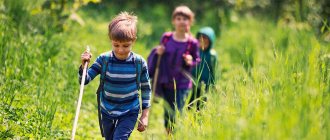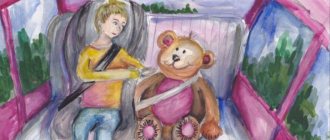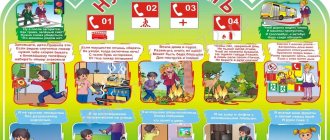Summer is a great holiday time for adults and children. Getting away from the city noise and smog, it’s so wonderful to hold various events in the forest. For children, any trip to the forest in the summer turns into an exciting adventure, full of riddles and secrets. There are so many interesting and unknown things around, and children’s curiosity takes over. If you do not follow the rules of behavior in the forest, such a trip can turn tragic for children. There are a number of rules and regulations that children must strictly follow to stay safe.
Safety regulations
If you go for a walk in the forest, carefully study the rules, following which you can ensure safety in the forest for children:
- Before you go on a hike, let your loved ones know where you are going. Knowing this, relatives will be able to seek help if necessary.
- Take dry matches, a watch and a compass on the road. Place a small knife in your pocket. It is possible that all this will come in handy on a forest walk.
- Bring extra food and water with you in case of delay. You should not eat unfamiliar berries or drink water from unknown sources.
- Wear bright outerwear, preferably with reflective details, so it will be easier for rescuers to notice you.
- Determine your route and stick to it at all times. There is no need to take shortcuts to get there faster if that means going through a swamp.
- If you have lost a friend, call rescuers immediately. There is no need to try to search on your own; you can destroy traces that will help in the search.
- Try to shout to the lost person, but try to stay in place.
- Bring first aid supplies on your hike. They may come in handy if someone gets sick.
- Inspect the road you are walking on so as not to fall into a hole and break your leg. Forest paths are not always well-trodden, this should not be forgotten.
- Don't leave trash behind, dig a hole in the ground and bury it. Never leave glass shards in the forest.
- Do not make a fire near trees; move at least 1.5 meters away from them. If you have a fireplace, you should not build a new one.
- When getting ready to go home, carefully extinguish the fire so that it does not start again after you leave. It is advisable to cover the fire with earth without scattering coals.
The forest is our wealth, we are its friends
Reminder in the form of a table:
| Absolutely NOT! | separate from the group, move away from adults; |
| go deep into the forest; | |
| eat anything without adult permission; | |
| touch baby animals with your hands, take them with you; | |
| make noise in the forest, listen to loud music; | |
| tease wild animals if you meet them; | |
| kill spiders, tear webs; | |
| catch insects unfamiliar to you. Their bites can be dangerous; | |
| break branches of bushes and trees; | |
| spread the fire; | |
| tear flowers and plants by the roots, because they will not grow again; | |
| leave inscriptions on tree bark; | |
| destroy anthills, they are forest orderlies; | |
| touch bird nests, take chicks with you; | |
| burn dry grass, branches and leaves. | |
| CAN | collect medicinal herbs under adult supervision; |
| collect edible mushrooms (under adult supervision), cutting them with a knife; | |
| pick wild strawberries; | |
| collect garbage left by careless tourists; | |
| If you're lost | stay in place, don’t run, as you can get even more lost; |
| call friends, relatives or teachers from a mobile phone; | |
| if there is no connection, dial the emergency number - 112 (always available); | |
| shout loudly, remaining in place, periodically listening, waiting for an answer. If you hear someone calling you, don’t follow the voices, just keep calling for help; | |
| If you are not found | listen to voices and sounds. Having heard the sounds of civilization (voices, music, noise of cars) - go in their direction, focusing on the volume (the louder the sounds, the closer you are); |
| moving forward, leave creases, nicks, and best of all, strings or things, so that those who look for you can know about your direction; | |
| try to remember where you entered the forest from and in what direction you were moving; | |
| if you find a stream, move in its direction - it will lead you to the river, and it is very likely that there may be people there; | |
| look around, do you see any stretched electrical wires? If yes, then follow them, they always go towards populated areas. |
The forest is magical, alluring and friendly. In order for your acquaintance to be useful and positive, remember the rules of behavior, which absolutely CANNOT be violated.
Rules of behavior in the forest
While in the forest, children must follow a number of simple rules of behavior:
- Stay constantly close to your loved ones, or within their visibility range.
- Do not pick or try unknown berries and mushrooms, they can be poisonous.
- Do not touch animals or insects. They can bite or carry serious infections. Do not pet or handle small cubs, as this can lead to serious consequences.
- Do not go close to lakes and reservoirs, and do not go into the water without adult permission. Water can hide many secrets, you need to remember this.
- At the first danger, immediately call an adult. There is no need to try to cope with the problem on your own; adult help will definitely come in handy.
Be careful, insects!
Goal: to develop in children an understanding of how to behave when encountering insects.
Materials: pictures depicting various insects.
The teacher shows the children pictures of insects. For example, ladybug, wasp, rhinoceros beetle and mosquito. The teacher asks:
- Are you familiar with these insects?
- What harm can they cause?
- Is there any way to protect yourself from them?
- What to do if you are bitten?
If the kids could not answer all the questions, the teacher prompts.
Then the teacher recites the poem, simultaneously showing the movements:
I was stung by a bee (He shows with his finger how a bee stings, and the children repeat after him) I shouted: “How could you!” (Everyone shouts together, “How could you?”) The bee responds: “How could you pick my favorite flower? (Shows how he picks a flower) After all, I really needed it: (Everyone buzzes together like bees) I was saving it for dinner!” (Show how a bee eats)
Then the teacher discusses with the children why the bee stung and how it could have been avoided. It is important to convey to children the idea that insects usually do not attack if they are not disturbed.
To reinforce the topic, the teacher conducts a quick survey with the children:
- What to do if a bee or wasp is flying near you? (don't wave your arms)
- What to do if you step on an anthill? (quickly leave this place and shake off the ants)
- What to do if you see a beetle? (pass by)
Reminder in pictures for preschoolers
When going for a walk in the forest, it would not be superfluous to once again remind preschool children about safe behavior in the forest. For children, rules of behavior and safety in the forest have been developed in pictures.
Each drawing is bright and catchy, attracts the child’s attention; stories in pictures about safety in the forest for children can be written in a convenient poetic form and are better remembered by children.
For example:
“You can’t throw glass in the forest, You can’t break bottles; Sharp fragments are dangerous - you will cut yourself terribly on them.”
By studying pictures in the form of a game, the child easily learns what can and cannot be done during forest walks. Compliance with forest laws is the key to the safety of adults and children.
The rules of behavior in nature for children, shown in the pictures, clearly demonstrate to the child how to behave so that trouble does not happen.
We organize the trip correctly
Children are curious and spontaneous creatures. No matter how well they learn the rules of behavior in the forest, once they are “in place” they can simply forget, get confused or get carried away by new experiences. Therefore, all responsibility falls on the shoulders of adults. Safety in the forest depends not only on the rules of behavior, but also on the organization of the trip. Adults should approach this with all seriousness, without missing a single important detail:
- Choosing a location. There are no “unexplored paths”; the hiking location must be safe, repeatedly traveled and known to the adults accompanying the children. You should not go deep into the forest, even if you know these places well. Wildlife is unpredictable.
- It's time to go. Choose the first half of the day for a hike in the forest. Don't forget that it gets dark in the forest earlier than in the city. The approaching twilight may make it difficult for you to get your bearings.
- Provisions. When going on a hike in the forest, take care of a snack. No raw meat - making a fire in a forest area is prohibited and dangerous. Let it be bread, salads, canned food, sausages and cheeses. Don't forget about drinking water. There should be enough of it, as well as food.
- Protection from insects. Everyone knows that there are much more bugs and mosquitoes of all kinds in the forest than in the city. Therefore, the backpack should have ointments, insect repellent sprays, and children (as well as you) should have scarves, panama hats and caps on their heads.
- Ratio of adults to children. There should be a lot of adults. Even if one or two teachers can easily cope with an entire class in the theater and museum, when going into the forest, enlist the support of parents and other teachers. Even the most obedient children in nature, when relaxing, behave more actively. Curiosity pushes children to violate even the strictest prohibitions, so they need to be monitored every minute. The younger the children, the more accompanying persons there should be. For a group of preschoolers, the ratio should ideally be “1 adult to 5 children.”
Rules for the safe behavior of child pedestrians on the roads
In addition, you should have all the necessary items on hand:
- Knife;
- Matches;
- Compass;
- Fully charged phone and portable battery, if available;
- Flashlight;
- First aid kit.
How to protect yourself from tick bites
The safety of children while walking in the forest directly depends on the attentiveness and responsibility of adults. Tick habitats cannot be determined visually. Therefore, it is important to know how to avoid their bites.
You need to dress your child correctly. White clothing on which ticks can be seen immediately is ideal. Completely protect your legs with high socks or tights, and tuck a T-shirt into them. Outerwear must have elastic bands, shoes must be completely closed, and a hat or scarf must be placed on the head.
It is necessary to take with you special preparations – repellents, which are periodically applied to the baby’s clothes. The child should be periodically examined to identify unwanted insects.
If, even with all the precautions taken, the baby is bitten by a tick, you must bring the insect for analysis. If analysis is not possible, the date of the bite should be recorded and the child monitored for three weeks. A runny nose, swelling or rash requires immediate medical attention.










